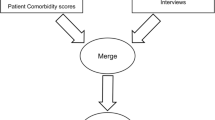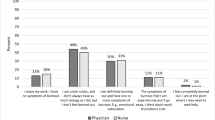Abstract
BACKGROUND
Two chronic care collaboratives (The National Collaborative and the California Collaborative) were convened to facilitate implementing the chronic care model (CCM) in academic medical centers and into post-graduate medical education.
OBJECTIVE
We developed and implemented an electronic team survey (ETS) to elicit, in real-time, team member’s experiences in caring for people with chronic illness and the effect of the Collaborative on teams and teamwork.
DESIGN
The ETS is a qualitative survey based on Electronic Event Sampling Methodology. It is designed to collect meaningful information about daily experience and any event that might influence team members’ daily work and subsequent outcomes.
PARTICIPANTS
Forty-one residency programs from 37 teaching hospitals participated in the collaboratives and comprised faculty and resident physicians, nurses, and administrative staff.
APPROACH
Each team member participating in the collaboratives received an e-mail with directions to complete the ETS for four weeks during 2006 (the National Collaborative) and 2007 (the California Collaborative).
KEY RESULTS
At the team level, the response rate to the ETS was 87% with team members submitting 1,145 narrative entries. Six key themes emerged from the analysis, which were consistent across all sites. Among teams that achieved better clinical outcomes on Collaborative clinical indicators, an additional key theme emerged: professional work satisfaction, or “Joy in Work”. In contrast, among teams that performed lower in collaborative measures, two key themes emerged that reflected the effect of providing care in difficult institutional environments—“lack of professional satisfaction” and awareness of “system failures”.
CONCLUSIONS
The ETS provided a unique perspective into team performance and the day-to-day challenges and opportunities in chronic illness care. Further research is needed to explore systematic approaches to integrating the results from this study into the design of improvement efforts for clinical teams.
Similar content being viewed by others
References
World Health Organization. Preventing Chronic Diseases: A Vital Investment: World Health Organization; 2005.
Bodenheimer T, Chen E, Bennett H. Confronting the growing burden of chronic disease: can the U.S. Health Care Workforce do the job? Health Aff. 2009;28(1):64–74.
Bodenheimer T, Wagner EH, Grumbach K. Improving primary care for patients with chronic illness: the chronic care model, Part 2. JAMA. 2002;288(15):1909–14.
Bodenheimer T, Wagner EH, Grumbach K. Improving primary care for patients with chronic illness. JAMA. 2002;288(14):1775–9.
Coleman K, Austin B, Brach C, Wagner EH. Evidence on the chronic care model in the new millennium. Health Aff. 2009;28(1):75–85.
Council on Graduate Medical Education. Physician Workforce Policy Guildelines for the United States, 2000–2020. Rockville, MD: COGME2005.
Wagner E, Austin B, Von Korff M. Organizing care for chronic disease. Millbank Quarterly. 1996;(74):511–44.
McCulloch D, Price M, Hindmarsh M, Wagner E. Improvement in diabetes care using an integrated population-based approach in a primary care setting. Dis Manag. 2000;3:75–82.
Stevens D, Bowen J, Johnson J, DM W, Provost L, Holman H, et al. A Multi-institutional quality improvement initiative to transform chronic illness care and education in resident continuity practices. J Gen Intern Med. 2010(XX:XX–XX).
Braithwaite J, Westbrook J, Ranmuthugala G, Cunningham F, Plumb J, Wiley J, et al. The development, design, testing, refinement, simulation, and application of an evaluation framework for communities of practice and social-professional networks. BMC Health Serv Res. 2009;9(162).
Wenger E, McDermott R, Synder W. Cultivating Communities of Practice. Boston: Harvard Business School Press; 2002.
Bowen J, Stevens D, Sixta C, Provost L, Johnson J, DM W, et al. Developing measures of educational change for collaborative teams implementing the chronic care model in teaching practice. J Gen Intern Med. 2010(XX:XX–XX).
Amabile T, Whitney D, Winstock J, Miller L, Fallang C. What Really Happens in Creative Projects: Event Sampling Through Electronic Data Collection. Cambridge: Harvard University; 1997.
Csikszentmihalyi M, Larson R. Validity and reliability of the experience-sampling method. J Nerv Mental Dis. 1987;175:526–36.
Larson R, Csikszentmihalyi M. The experience sampling method. New Dir Methodol Soc Behav Sci. 1983;15:41–56.
Amabile T, Barsade S, Mueller J, Staw B. Affect and creativity at work. Adm Sci Q. 2005;50(3):367–403.
Scientific Software Development Company G. ATLAS.ti. Berlin, Germany.
Boeije H. A purposeful approach to the constant comparative method in the analysis of qualitative interviews. Qual Quant. 2002(36):3392–40.
Strauss A, Corbin J. Basics of Qualitative Research. 2nd ed. Thousand Oaks: Sage Publications; 1998.
Institute for Healthcare Improvement. Assessment Scale for Collaboratives. Boston: Institute for Healthcare Improvement; 2004.
Schon D. The Reflective Practitioner: How Professionals Think in Action. USA: Basic Books, Inc; 1983.
Csikszentmihalyi M. Creativity: Flow and the Psychology of Discovery and Invention. New York: Harper-Collins; 1996.
Amabile T, Hadley C, Kramer S. Creativity under the gun. Harvard Business Review. 2002;80(8):52–61.
Bakke D. Joy at Work: A Revolutionary Approach to Fun on the Job. Seattle: PVG; 2005.
Acknowledgements
The national staff and faculty for the Academic Chronic Care Collaboratives were supported by generous grants from the Robert Wood Johnson Foundation and the California HealthCare Foundation. The work reported in this manuscript was presented at the Academy Health Annual Research Meeting. June 28, 2009. Chicago, Illinois.
Conflict of Interest
None disclosed.
Author information
Authors and Affiliations
Corresponding author
Rights and permissions
About this article
Cite this article
Johnson, J.K., Woods, D.M., Stevens, D.P. et al. Joy and Challenges in Improving Chronic Illness Care: Capturing Daily Experiences of Academic Primary Care Teams. J GEN INTERN MED 25 (Suppl 4), 581–585 (2010). https://doi.org/10.1007/s11606-010-1408-8
Published:
Issue Date:
DOI: https://doi.org/10.1007/s11606-010-1408-8




